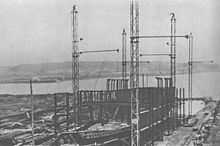Olza (ship, 1939)
|
Model of the Olza in the Maritime Museum in Gdansk
|
||||||||||||||||||||||||
|
||||||||||||||||||||||||
|
||||||||||||||||||||||||
|
||||||||||||||||||||||||
|
||||||||||||||||||||||||
The Olza was the first cargo ship built in Poland in 1939 , but remained unfinished - even as the German West Prussia . After 1945 it was completed as a passenger and cargo ship Ingul for fishing in the Soviet Union and taken out of service in 1970.
Technical specifications
The length of the ship was 68.20 meters, it was 10.70 meters wide and had a draft of 6.60 meters. It was measured at 1080 GRT and had a load capacity of 1350 tons. The drive consisted of a triple expansion machine with an output of 850 hp . This acted on a screw , the steamer should reach a speed of 11.0 knots . Eighteen men were provided for the crew.
history
Start of construction for Żegluga Polska
After the Stocznia Gdynia shipyard, founded in 1922, had gained initial experience with repairs and the new construction of the minesweeper ORP Mewa , the state-owned shipping company Żegluga Polska commissioned the shipyard with the construction of Poland's first cargo ship. The design for the ship came from the British shipyard J. Samuel White from Cowes , while all building materials, equipment and the engine were of Polish origin. At the shipyard was on 28 August 1938, the hull number 11 of the B keel laid . The launch was scheduled for September 25th, completion for mid-December 1939.
The steamer was originally supposed to be named Zaolzie , the Polish name of the Czechoslovak region west of the Olsa River . With this name, the government in Warsaw underscored Poland's claim to this area. When Poland occupied the Olsa area as a result of the Munich Agreement , the steamer was now to be named Olsa after the river of the same name.
At the beginning of the Second World War , the ship was still unfinished on the slipway . In order not to have to leave the ship to the Germans, the shipyard continued work. The early emergency launch on September 2 (according to other information on September 8) failed because the ship got stuck on the slipway.
Further construction for the German Empire
The slightly damaged ship lying on the slipway fell into German hands on September 14. Probably in March 1940, Deutsche Werke Gotenhafen received the order from Deutsche Werke in Kiel to continue building the ship, renamed "West Prussia", for the Gotenhafen naval arsenal - this is how Gdynia was now called. It was launched in May 1941. The ship was then towed to Libau , where it was to be completed in the Libau naval equipment and repair facility . There, too, the construction was not completed, in April 1944 a delivery date could still not be given. In the same year the unfinished building was handed over to the Navy on October 10th and towed to Königsberg loaded with shipbuilding material . On January 21st, the ship became Soviet spoils of war there.
Soviet fishing aid ship in Kaliningrad
The still unfinished ship was towed to Klaipėda or Kaliningrad after the end of the war and handed over to the Kaliningrad Fisheries Combine (Zapryba?). The history of the ship remains open until 1958, in that year it was completed and was named Ingul after the Inhul River in what is now Ukraine . The Ingul was recorded in western literature , but without its origin being known. Without shipyard information, it was recorded with the year of construction 1958 and 1570 GRT, 714 NRT with 1207 tdw and dimensions of 73.2 meters in length, 10.7 meters in width and a draft of 4.5 meters. The steam engine had been replaced by a diesel engine with 800 hp, which brought the ship to 10 knots. The ship was now used as a passenger and cargo ship in the Kaliningrad fishing fleet. It remains unclear whether it was used as a fish transporter and / or as a recreation and exchange ship for the fishermen. On June 3, 1970 the Ingul was decommissioned.
See also
literature
- Jan Piwowoński: Flota spod biało-czerwonej [Fleet under white and red] , Nasza Księgarnia Publishing House, Warsaw 1989, ISBN 83-10-08902-3 .
- Reinhart Schmelzkopf: Foreign ships in German hands 1939–1945. Strandgut-Verlag, Cuxhaven 2004, DNB 972151001 .
- Bruno Bock, Klaus Bock: The red merchant fleets. The merchant ships of the COMECON countries , Koehlers Verlagsgesellschaft, Herford 1977, ISBN 3-7822-0143-4 .
Web links
- Theodor Dorgeist: whereabouts of the first Polish seagoing vessel "Olza" built in Poland , article in forum-marinearchiv.de from October 7, 2014 , accessed on April 12, 2020
- Stefan Krol: The name Olza as a brand , museum website of the city of Cieszyn (Polish / English), accessed on April 12, 2020
Individual evidence
- ↑ Piwowonski, p 55
- ↑ a b melt head, p. 182
- ↑ a b c d Krol
- ↑ Piwowonski, p. 54
- ↑ a b c d Dorgeist
- ↑ Naval equipment and repair companies of the Kriegsmarine were branches of the two naval arsenals in Wilhelmshaven and Kiel created in Germany and in the occupied territories during the Second World War. As the navy's own shipyards, they carried out repairs and conversions of ships for the navy and provided their equipment.
- ↑ Bock, p. 209

